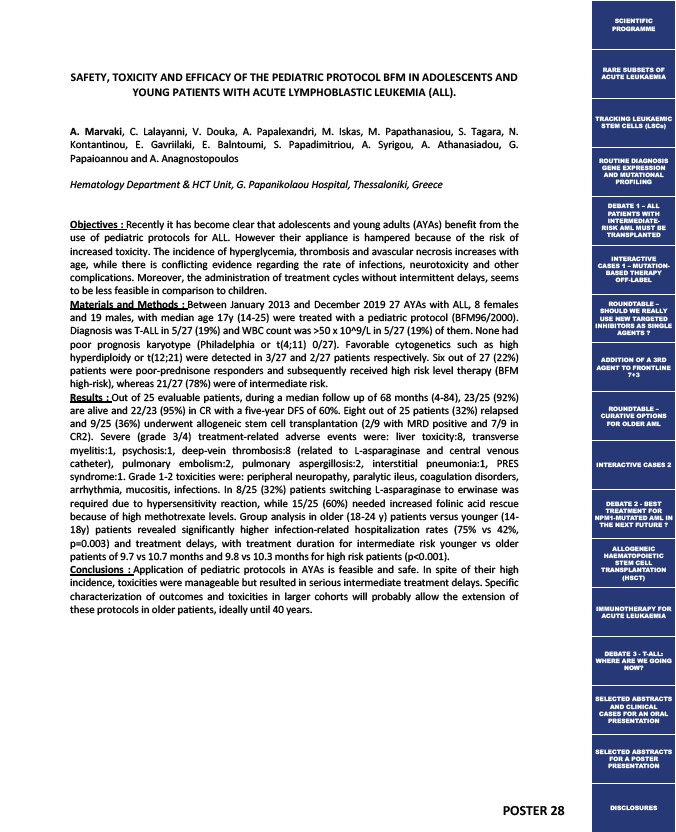
SAFETY, TOXICITY AND EFFICACY OF THE PEDIATRIC PROTOCOL BFM IN ADOLESCENTS AND
POSTER 28
YOUNG PATIENTS WITH ACUTE LYMPHOBLASTIC LEUKEMIA (ALL).
A. Marvaki, C. Lalayanni, V. Douka, A. Papalexandri, M. Iskas, M. Papathanasiou, S. Tagara, N.
Kontantinou, E. Gavriilaki, E. Balntoumi, S. Papadimitriou, A. Syrigou, A. Athanasiadou, G.
Papaioannou and A. Anagnostopoulos
Hematology Department & HCT Unit, G. Papanikolaou Hospital, Thessaloniki, Greece
Objectives : Recently it has become clear that adolescents and young adults (AYAs) benefit from the
use of pediatric protocols for ALL. However their appliance is hampered because of the risk of
increased toxicity. The incidence of hyperglycemia, thrombosis and avascular necrosis increases with
age, while there is conflicting evidence regarding the rate of infections, neurotoxicity and other
complications. Moreover, the administration of treatment cycles without intermittent delays, seems
to be less feasible in comparison to children.
Materials and Methods : Between January 2013 and December 2019 27 AYAs with ALL, 8 females
and 19 males, with median age 17y (14-25) were treated with a pediatric protocol (BFM96/2000).
Diagnosis was T-ALL in 5/27 (19%) and WBC count was >50 x 10^9/L in 5/27 (19%) of them. None had
poor prognosis karyotype (Philadelphia or t(4;11) 0/27). Favorable cytogenetics such as high
hyperdiploidy or t(12;21) were detected in 3/27 and 2/27 patients respectively. Six out of 27 (22%)
patients were poor-prednisone responders and subsequently received high risk level therapy (BFM
high-risk), whereas 21/27 (78%) were of intermediate risk.
Results : Out of 25 evaluable patients, during a median follow up of 68 months (4-84), 23/25 (92%)
are alive and 22/23 (95%) in CR with a five-year DFS of 60%. Eight out of 25 patients (32%) relapsed
and 9/25 (36%) underwent allogeneic stem cell transplantation (2/9 with MRD positive and 7/9 in
CR2). Severe (grade 3/4) treatment-related adverse events were: liver toxicity:8, transverse
myelitis:1, psychosis:1, deep-vein thrombosis:8 (related to L-asparaginase and central venous
catheter), pulmonary embolism:2, pulmonary aspergillosis:2, interstitial pneumonia:1, PRES
syndrome:1. Grade 1-2 toxicities were: peripheral neuropathy, paralytic ileus, coagulation disorders,
arrhythmia, mucositis, infections. In 8/25 (32%) patients switching L-asparaginase to erwinase was
required due to hypersensitivity reaction, while 15/25 (60%) needed increased folinic acid rescue
because of high methotrexate levels. Group analysis in older (18-24 y) patients versus younger (14-
18y) patients revealed significantly higher infection-related hospitalization rates (75% vs 42%,
p=0.003) and treatment delays, with treatment duration for intermediate risk younger vs older
patients of 9.7 vs 10.7 months and 9.8 vs 10.3 months for high risk patients (p<0.001).
Conclusions : Application of pediatric protocols in AYAs is feasible and safe. In spite of their high
incidence, toxicities were manageable but resulted in serious intermediate treatment delays. Specific
characterization of outcomes and toxicities in larger cohorts will probably allow the extension of
these protocols in older patients, ideally until 40 years.
SCIENTIFIC
PROGRAMME
RARE SUBSETS OF
ACUTE LEUKAEMIA
TRACKING LEUKAEMIC
STEM CELLS (LSCs)
ROUTINE DIAGNOSIS
GENE EXPRESSION
AND MUTATIONAL
PROFILING
DEBATE 1 – ALL
PATIENTS WITH
INTERMEDIATE-RISK
AML MUST BE
TRANSPLANTED
INTERACTIVE
CASES 1 – MUTATION-BASED
THERAPY
OFF-LABEL
ROUNDTABLE –
SHOULD WE REALLY
USE NEW TARGETED
INHIBITORS AS SINGLE
AGENTS ?
ADDITION OF A 3RD
AGENT TO FRONTLINE
7+3
ROUNDTABLE –
CURATIVE OPTIONS
FOR OLDER AML
INTERACTIVE CASES 2
DEBATE 2 - BEST
TREATMENT FOR
NPM1-MUTATED AML IN
THE NEXT FUTURE ?
ALLOGENEIC
HAEMATOPOIETIC
STEM CELL
TRANSPLANTATION
(HSCT)
IMMUNOTHERAPY FOR
ACUTE LEUKAEMIA
DEBATE 3 - T-ALL:
WHERE ARE WE GOING
NOW?
SELECTED ABSTRACTS
AND CLINICAL
CASES FOR AN ORAL
PRESENTATION
SELECTED ABSTRACTS
FOR A POSTER
PRESENTATION
DISCLOSURES